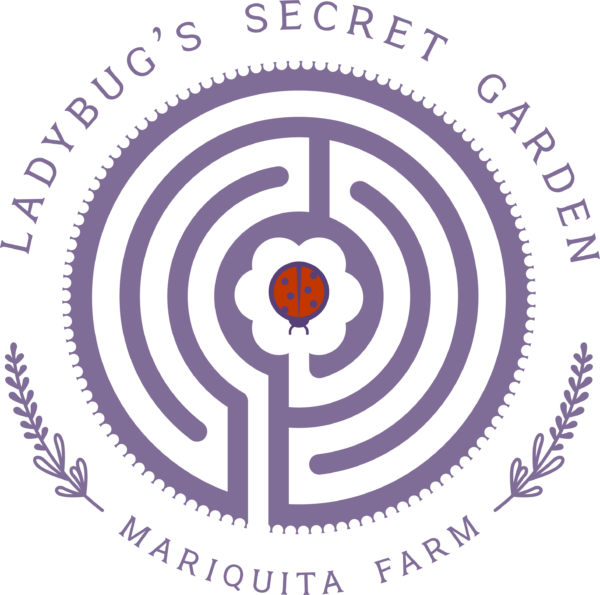Letters From Andy
Ladybug Letters
Cinderella’s Brunch
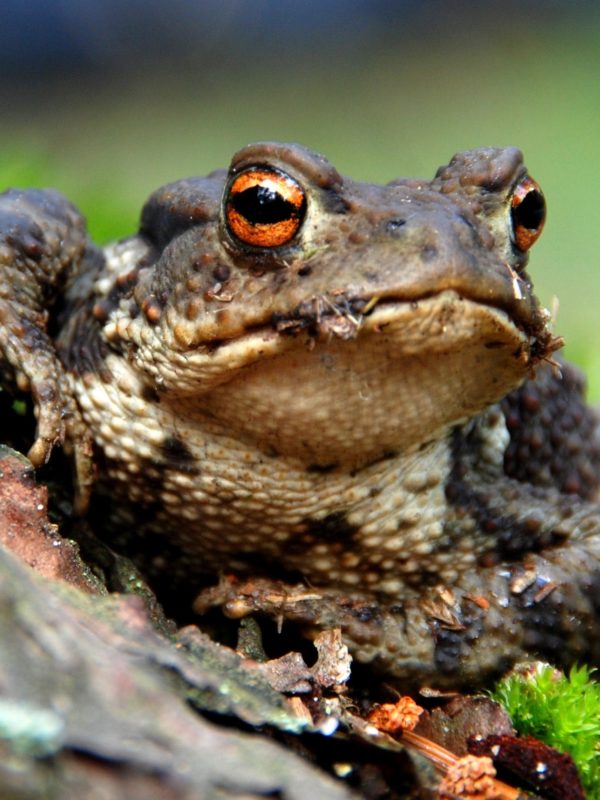
Once upon a time in a land far, far, away Little Red Riding Hood went to brunch with her besties at The Fairy Godmother’s Cauldron. Boots, the waiter, guided her through the crowded room to their regular table. Cinderella was already seated. A Princess with an unusual sensitivity to legumes arrived moments later and, after a round of curtsies and kisses, the three settled into a bucket of Champagne mimosas. The conversation turned to love and relationships.
“Is your Prince still ‘charming,’ ” Red asked Cindy.
Cinderella’s glass was empty. Boots scuttled over and refilled it. She took a sip of the syrupy, sweet drink and took her time in answering.
“I kissed him and he turned into a frog,” she finally replied. The women shared a bitter laugh, and that’s when “It” all started; this disrespect and disinterest the public seems to have for the valiant, valuable, and humble frog. These days the popular press is full of accounts of Prince Andrew’s infidelities and iniquities. Prince Charles’s failed marriage to Diana is the stuff of legend. Accounts of Prince Harry’s trials and tribulations with Meghan Markle are obsessively recounted by the tabloids. But almost nobody pays attention to the plight of our frog friends.
Frogs are amphibians and most species require wetland environments to resolve their romantic and procreative issues. All over the world the frog population is in steep decline as the dramatic reduction in their habitat and the consequences of climate change takes its toll. The decline in frog populations is bad news for humans. Can you name a single prince who has justified his privileged aristocratic status by consuming his weight in mosquitoes? And it’s not just mosquitos; flies and insect pests of all kinds are zapped up by frogs’ long, sticky tongues.
I don’t use any biocides on my farm, be they organically derived pesticides or conventional chemicals. I have distaste for sprays and an unwillingness to subject others or myself to pesticides. But farming without pesticides comes with risks. Sometimes the pests overwhelm a crop of mine and destroy it. But mostly they don’t, and I count on frogs to help control many of the pests that could threaten my greens.
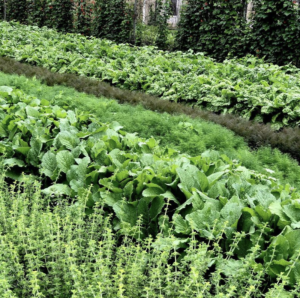 Our greenhouse is next to a ditch that drains farm fields into Corralitos Creek. Our neighborhood frogs romance each other and lay their eggs in the muddy ditch each spring. Then the little frogs that survive all the predators hop their way from their weedy ditch into our greenhouse. The greenhouse roof acts to protect the frogs from airborne threats like Great Blue Herons and Snowy Egrets. Our farm’s happy frogs find a green and moist welcome among the chard leaves and carrot fronds.
Our greenhouse is next to a ditch that drains farm fields into Corralitos Creek. Our neighborhood frogs romance each other and lay their eggs in the muddy ditch each spring. Then the little frogs that survive all the predators hop their way from their weedy ditch into our greenhouse. The greenhouse roof acts to protect the frogs from airborne threats like Great Blue Herons and Snowy Egrets. Our farm’s happy frogs find a green and moist welcome among the chard leaves and carrot fronds.
I manage my greenhouse production by scattering rows of short-term annuals, like arugula, collards, or baby carrots, among rows of long-term annuals like peppers or runner beans and rows of perennial crops like Hoja Santa, or Lemon Verbena. That way, when I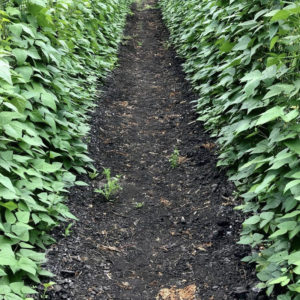 turn the tractor down a spent row that needs to be tilled under and replanted, the frogs that are hiding in the greenery have an opportunity to move to a safe space just a row or two away. I was on the tractor this past week and it was fun to see the frogs hopping out of my way as the tractor crept down the row. When I was tilling under an old bed of overgrown mizuna greens the frogs that bounced out of my way were a lovely jade green, just like the mizuna. When I turned under the red-veined sorrel the frogs were a burgundy bronze, just like the old, ratty sorrel leaves. When I turned under a bed that was covered in dried weeds the frogs that fled were brown and almost yellow, just like the weeds that had been hiding them.
turn the tractor down a spent row that needs to be tilled under and replanted, the frogs that are hiding in the greenery have an opportunity to move to a safe space just a row or two away. I was on the tractor this past week and it was fun to see the frogs hopping out of my way as the tractor crept down the row. When I was tilling under an old bed of overgrown mizuna greens the frogs that bounced out of my way were a lovely jade green, just like the mizuna. When I turned under the red-veined sorrel the frogs were a burgundy bronze, just like the old, ratty sorrel leaves. When I turned under a bed that was covered in dried weeds the frogs that fled were brown and almost yellow, just like the weeds that had been hiding them.
Frogs can change colors to fit their surroundings, which is pretty enchanting. For me, frogs are magic because they eat the carrot flies that hover close to the ground and would lay eggs and spread their little, destructive maggots in among our umbelliferous crops like carrots, parsley, chervil, dill, or lovage. Frogs zap up the white flies that would cling to our pepper crops and chew away at our profits. The sticky, waxy aphids that want to eat our chards and lettuces are held in check by our vigilant posse of little amphibians. If Cinderella kissed a Prince and their relationship didn’t develop into the mutually supportive growth experience that she’d hoped for, that’s because….well, life’s no Fairy Tale. But we do the planet a favor when we host our frog friends by providing them with an amenable habitat, and they never betray our friendship by turning into aristocrats.
—© 2021 Essay by Andy Griffin and photos of farm by Andy Griffin
Photo of frog by Pixabay
~Special Note~
As the weather is getting warmer, the sun is rising earlier and the harvesting begins with the sunrise, we will be closing our East Bay/Peninsula shop by 6 PM on the Wednesday evenings before the Friday delivery. We close our San Francisco & Mystery Thursday shops on Wednesday mornings by 8 AM and our Santa Cruz/Los Gatos shop by 8 AM, on Monday mornings. Please get your orders in early so you don’t miss out on the harvest! Thank you all again for being such a part of our bountiful farm!
If you haven’t ordered a Mystery Box recently, now is a great time to get in on spring deliciousness! LadybugBuyingClub
We Are Stardust
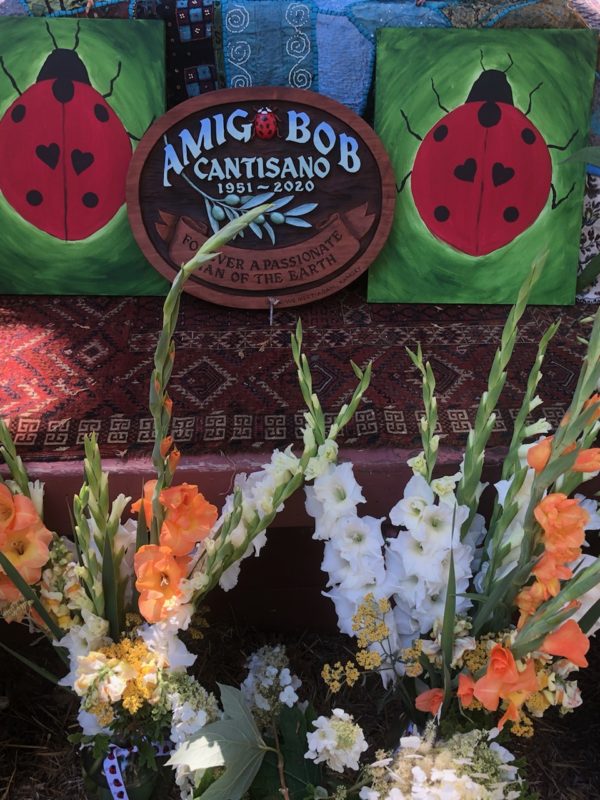
A little country schoolhouse in the woods adjacent to the site of one of America’s most egregious environmental crimes made a perfect setting for the memorial service. A gentle breeze stroked the pines and eased the 102-degree summer heat as the mourners began to arrive. Many folks tumbled out of vans or stepped down from pick-up trucks, brightly dressed for the occasion in their best tie-dyed formal wear as had been suggested by the grieving family. I didn’t see any black in the crowd, but there were also people in colorful prints and stripes, and a few folks chose to wear next to nothing at all. Excited children ran loose on the grass in the sun and there were glass pitchers of iced, herbal teas and lemonade waiting in the shade. You could hear the music of acoustic guitars and harps coming from a duo down by the makeshift altar where the grownups were gathering. There was a life to be celebrated and honored here, but first let’s talk about the crime.
Malakoff Diggins on the San Juan Ridge North of Nevada City in the Sierra Nevada Gold Country is a vast blight on the landscape that has been re-imagined as a State Park. When California’s Gold Rush matured in the mid1850s the business of gold mining became very industrialized. Gone were the days of the ’49ers bent over in a river panning for gold nuggets. Capitalists raised money for mining companies to dam creeks and rivers high in the mountains. Then they’d cut down the pine forests to build wooden sluices that would guide the wild water down from great heights to the lower elevations in the foothills. The sluices would be channeled into huge hoses and, thanks to the tremendous pressure from the dramatic descent, the water exploded out of the nozzles with violent, cutting force. Whole hillsides would be washed away in a muddy torrent and the raging slurry would be strained for gold through a series of sluices. Malakoff Diggins is the scar left from one of the largest hydraulic mines. There are eroded canyons where there once were hills. The soil was washed away down to bedrock so a visitor can see deep into the planet’s bones. The park’s stunted forest is struggling to heal the violated earth.
To California’s 19th Century mining industry, it didn’t matter that her forests were destroyed. It wasn’t relevant to the shareholders of the mining corporations that the mud flows from their hydraulic mining polluted rivers and destroyed fisheries and whole ecosystems. It wasn’t a problem for the mining industry that the waste from hydraulic mining destroyed farm fields and flooded cities and ruined bays and wetlands downstream. The only thing that mattered to the mining companies was extracting gold from the ground as fast and as cheaply as possible. The miners had zero social consciousness and their “industry” was a rape. The only thing the mining companies could have done to behave in a less socially conscious manner would have been to use slave labor.
Eventually, the number of citizen victims in California so vastly outnumbered the handful of capitalists who controlled the hydraulic mining business that it became politically expedient for the California Legislature to pass America’s first environmental legislation and ban hydraulic mining. It helped that the Sacramento River, which passes close by to California’s Legislature, was so full of mud from the mines that it overflowed frequently and flooded the politicians. The law was important not only because it put a halt to an egregious crime against our environment but also because it set precedent by showing how the wellbeing of the body politic was dependent on the wise management of the land and water resources that sustain the community. Maybe that moment when our legislature first acted with an awareness of the environment was an inflection point; at any rate, starting in the late 19th Century there was a growing social awareness of our role in destroying or conserving our shared environment. At first it seemed like only the poets and artists and mystics and bohemian freaks could see our natural world as anything more than a piggy bank to be busted open for coins.
Amigo Bob was born in 1951. Post War America was the boom time for chemical  agriculture. The threat we face from chemical residues in our food and water is never as obvious as a wave of mud spilling over a riverbank but it’s just as real. In the late 50’s consumers were ignorant and didn’t understand about the ways chemical laced runoff from farms was altering and degrading our rivers, lakes, and aquifers. We didn’t have a widespread public understanding of our farmlands as an irreplaceable resource to be conserved. The “modern” in everything was being fetishized and what had been traditionally valued was seen as outdated, so antique varieties of grains, fruits and vegetables were being forgotten from cultivation. The Universities only taught the gospel of “Better Living Thru Chemistry.” But there was also a nascent counterculture springing up that sought to reconnect our society with the natural world that sustains us. Joni Mitchell captured the moment in her song, Woodstock; “We are stardust,” she sang. “We are golden. And we’ve got to get back to the garden.” Amigo Bob had a hippy memorial service because he was a straight up, tie-dyed in the wool, unapologetic and incurable hippy.
agriculture. The threat we face from chemical residues in our food and water is never as obvious as a wave of mud spilling over a riverbank but it’s just as real. In the late 50’s consumers were ignorant and didn’t understand about the ways chemical laced runoff from farms was altering and degrading our rivers, lakes, and aquifers. We didn’t have a widespread public understanding of our farmlands as an irreplaceable resource to be conserved. The “modern” in everything was being fetishized and what had been traditionally valued was seen as outdated, so antique varieties of grains, fruits and vegetables were being forgotten from cultivation. The Universities only taught the gospel of “Better Living Thru Chemistry.” But there was also a nascent counterculture springing up that sought to reconnect our society with the natural world that sustains us. Joni Mitchell captured the moment in her song, Woodstock; “We are stardust,” she sang. “We are golden. And we’ve got to get back to the garden.” Amigo Bob had a hippy memorial service because he was a straight up, tie-dyed in the wool, unapologetic and incurable hippy.
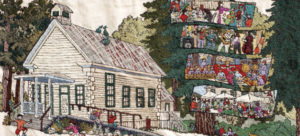 The North Columbia Schoolhouse is a community center for the people who live up and down the San Juan Ridge. The Malakoff Diggins State Park is just around the corner. Amigo Bob may have started off in San Francisco, but he ended up living and farming nearby. What a difference one hundred years makes. Where the gold miners had seen the soil on San Juan Ridge as an obstruction inconveniently hiding treasure, the hippies like Amigo Bob saw the soil as the real treasure. Where the mining companies had no shame in flushing their unfiltered wastes into the whole public’s ecosystem, the hippies envisioned a movement back to the land characterized by a rainbowed network of environmentally sustainable communities where nature was recognized as a partner, not as an adversary. Amigo Bob came out of that loose, nature-centric hippie community and he lived his life as an activist for those life-affirming, scientific, and transcendent values. Amigo Bob put the “active” in “activist.”
The North Columbia Schoolhouse is a community center for the people who live up and down the San Juan Ridge. The Malakoff Diggins State Park is just around the corner. Amigo Bob may have started off in San Francisco, but he ended up living and farming nearby. What a difference one hundred years makes. Where the gold miners had seen the soil on San Juan Ridge as an obstruction inconveniently hiding treasure, the hippies like Amigo Bob saw the soil as the real treasure. Where the mining companies had no shame in flushing their unfiltered wastes into the whole public’s ecosystem, the hippies envisioned a movement back to the land characterized by a rainbowed network of environmentally sustainable communities where nature was recognized as a partner, not as an adversary. Amigo Bob came out of that loose, nature-centric hippie community and he lived his life as an activist for those life-affirming, scientific, and transcendent values. Amigo Bob put the “active” in “activist.”
In the early ’70s Amigo Bob worked with other consumers to create food buying clubs that could source organic, chemical-free foods for the members. When he found that there was very little organic food to be had he started farming. When he ran into the inevitable challenges as an organic grower he began researching organic farm supplies and ended up starting Peaceful Valley Farm Supply in Grass Valley, a first generation organic farm supply business that is still serving the industry today. When the growth of the organic food business created concerns about standards, Amigo worked with others to link farmers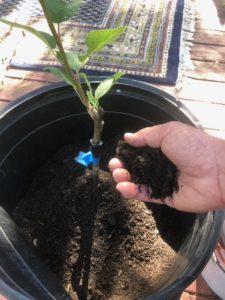 together to craft reasonable, enforceable and transparent standards for the industry. He persisted in trying to get the Universities to work on the challenges facing organic agriculture. When the schools were slow to take up the challenge of learning how to solve agricultural problems organically, Amigo Bob worked with others to create the Eco Farm Conference, which brought farmers, scientists, and activists together. Amigo farmed olives and his olive oil business brought him into the world of fine dining and he helped create an awareness among chefs about the role small farms could play in supplying Restaurant kitchens with fresh ingredients. He worked to save rare and endangered fruit varieties from being lost and he founded the Gillet Institute to institutionalize these goals. https://felixgillet.org/ . Amigo started a farming consulting business to help teach other aspiring and established farmers what he’s learned. For a fitting coda to his life Amigo chose to be composted and turned back into the earth instead of having his body embalmed and boxed up.
together to craft reasonable, enforceable and transparent standards for the industry. He persisted in trying to get the Universities to work on the challenges facing organic agriculture. When the schools were slow to take up the challenge of learning how to solve agricultural problems organically, Amigo Bob worked with others to create the Eco Farm Conference, which brought farmers, scientists, and activists together. Amigo farmed olives and his olive oil business brought him into the world of fine dining and he helped create an awareness among chefs about the role small farms could play in supplying Restaurant kitchens with fresh ingredients. He worked to save rare and endangered fruit varieties from being lost and he founded the Gillet Institute to institutionalize these goals. https://felixgillet.org/ . Amigo started a farming consulting business to help teach other aspiring and established farmers what he’s learned. For a fitting coda to his life Amigo chose to be composted and turned back into the earth instead of having his body embalmed and boxed up.
As an activist Amigo Bob really covered all the bases and his memorial service was a chance for the community that he sprang from and inspired to gather together and say thanks for a life well lived. Amigo will be missed but the crowd that gathered to remember him spanned all ages and the work goes on. Amigo would be happy to see that the environmental values that he promoted are gathering momentum as day-by-day more people learn to see our shared world from a more holistic perspective.
“All of your actions, no matter how small, can have a huge impact on the environment and all the humans and creatures that inhabit it.”
Amigo Bob 1951- 2020
—© 2021 Essay by Andy Griffin and photos by Starling Linden and Andy Griffin
~Special Note~
As the weather is getting warmer, the sun is rising earlier and the harvesting begins with the sunrise, we will be closing our East Bay/Peninsula shop by 6 PM on the Wednesday evenings before the Friday delivery. We close our San Francisco & Mystery Thursday shops on Wednesday mornings by 8 AM and our Santa Cruz/Los Gatos shop by 8 AM, on Monday mornings. Please get your orders in early so you don’t miss out on the harvest! Thank you all again for being such a part of our bountiful farm!
If you haven’t ordered a Mystery Box recently, now is a great time to get in on spring deliciousness! LadybugBuyingClub
For Plants, Everyday is “Sun” Day!
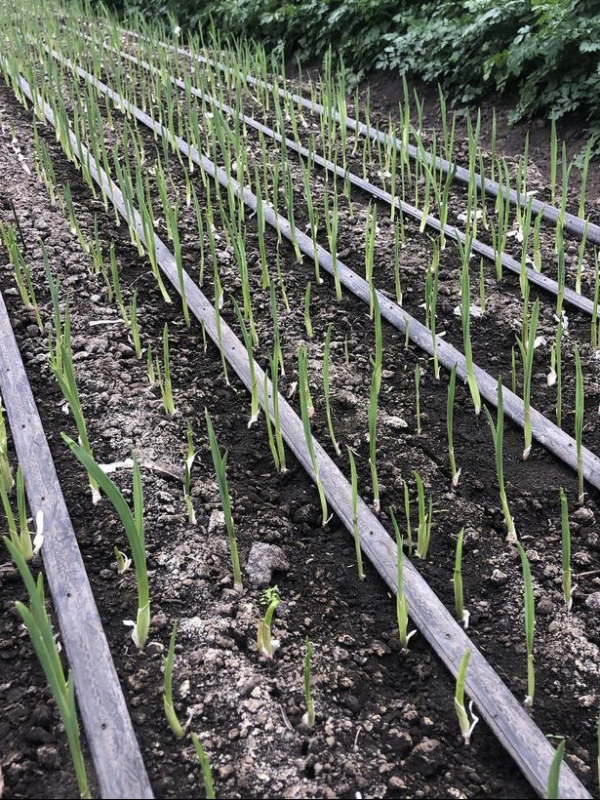
Fathers Day fell on June 20th this year and seemed to get more attention in the media than the Summer Solstice did. But plants noticed the solstice. Maybe it’s just that the plant kingdom doesn’t take strict gender norms as seriously as humans do. The garlic family, for example, is happy to reproduce itself asexually by dispersing cloven clones. Marijuana- and many other plants- are happy to have male, female, and hermaphrodite plants. And plenty of plants, like willow trees, are perfectly comfortable falling over and then rooting into the earth from branches that touch the ground. But if plants don’t follow humanity’s traditional sexual conventions they do all bow to the sun’s power.
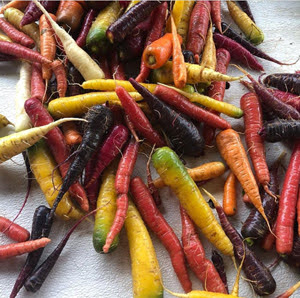 Plants aren’t as dumb as some people think. Many plants, like some of the interesting rainbow colored carrot varieties, will very happily sprout and grow vigorously no matter what time of the year they’re planted- but they won’t form a fat, carrot-like root. But if you plant these day length sensitive varieties after the solstice these carrots will notice that the days are getting shorter. They understand that winter is coming and they’ll form nice, fat, sugar-packed roots so that they have enough stored energy to power the growth of a flower stalk in the following spring. As a consumer, I enjoy purple, red, and even “black” carrots, but as a farmer I know to respect the sensitivities of these kinds of carrots and I wait until after the solstice to plant them.
Plants aren’t as dumb as some people think. Many plants, like some of the interesting rainbow colored carrot varieties, will very happily sprout and grow vigorously no matter what time of the year they’re planted- but they won’t form a fat, carrot-like root. But if you plant these day length sensitive varieties after the solstice these carrots will notice that the days are getting shorter. They understand that winter is coming and they’ll form nice, fat, sugar-packed roots so that they have enough stored energy to power the growth of a flower stalk in the following spring. As a consumer, I enjoy purple, red, and even “black” carrots, but as a farmer I know to respect the sensitivities of these kinds of carrots and I wait until after the solstice to plant them.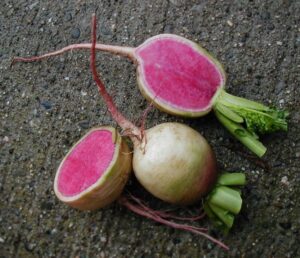 majority of the plant’s growth comes during the declining days after the solstice. The very largest Watermelon radishes are produced by planting right around the summer solstice so that the plant frames up during the longest days and can capture the most energy and make the biggest root. Watermelon radishes planted late in summer or early in fall, will not enjoy as much of the sun’s energy, so they’ll form a smaller root. If you plant these radishes in the dead of winter they’ll sprout alright, but under the influence of the ever longer days after the Winter solstice they’ll “run straight to stick,” as we say, and make a flower stalk without ever forming a root.
majority of the plant’s growth comes during the declining days after the solstice. The very largest Watermelon radishes are produced by planting right around the summer solstice so that the plant frames up during the longest days and can capture the most energy and make the biggest root. Watermelon radishes planted late in summer or early in fall, will not enjoy as much of the sun’s energy, so they’ll form a smaller root. If you plant these radishes in the dead of winter they’ll sprout alright, but under the influence of the ever longer days after the Winter solstice they’ll “run straight to stick,” as we say, and make a flower stalk without ever forming a root.—© 2021 Essay by Andy Griffin and photos by Starling Linden and Andy Griffin
~Special Note~
As the weather is getting warmer, the sun is rising earlier and the harvesting begins with the sunrise, we will be closing our East Bay/Peninsula shop by 6 PM on the Wednesday evenings before the Friday delivery. We close our San Francisco & Mystery Thursday shops on Wednesday mornings by 8 AM and our Santa Cruz/Los Gatos shop by 8 AM, on Monday mornings. Please get your orders in early so you don’t miss out on the harvest! Thank you all again for being such a part of our bountiful farm!
If you haven’t ordered a Mystery Box recently, now is a great time to get in on spring deliciousness! LadybugBuyingClub
Our Lady’s Birds

In England, early images of The Virgin Mary often portrayed her wearing a scarlet robe so it made sense from a medieval perspective to call the little red-shelled beetles that made the gardens their homes “Our Lady’s Birds.” The English Seven Spot Ladybird beetle’s “look,” rocking black spots on a shiny red shell is so striking and memorable that it’s image “branded” the entire family forever. When you factor in that the seven black spots on the Ladybird beetle’s shell recall the Virgin Mother’s “Seven Sorrows,” then the name is even richer in meaning. When Our Lady’s Birds crossed the Atlantic to the Americas they got their names changed at Ellis Island, just like so many other immigrants. The name, “Ladybug,” is an Americanism.
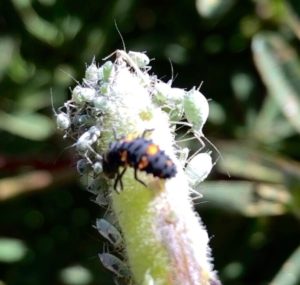 Be they birds, bugs, or beetles, these cute little creatures are fierce predators in the garden and gobble many times their weight in pesty aphids during their lives. Interestingly enough, the Ladybugs that eat the most pests don’t look like Ladybugs at all. Like all beetles, the Ladybugs have a larval form of life before they pupate and become the cute, red shelled, black spotted creatures we love to find in our gardens. The larval, or nymph stage, ladybugs eat a lot more pests than the mature, hard-shelled forms. For the gardener, the goal has to be to create an environment so attractive to the Ladybugs that the mature beetles fly in, have a meal, then decide to lay eggs. If you buy a jar of ladybugs and turn them loose in your garden they may all fly away. So save your money and create the garden they fly to!
Be they birds, bugs, or beetles, these cute little creatures are fierce predators in the garden and gobble many times their weight in pesty aphids during their lives. Interestingly enough, the Ladybugs that eat the most pests don’t look like Ladybugs at all. Like all beetles, the Ladybugs have a larval form of life before they pupate and become the cute, red shelled, black spotted creatures we love to find in our gardens. The larval, or nymph stage, ladybugs eat a lot more pests than the mature, hard-shelled forms. For the gardener, the goal has to be to create an environment so attractive to the Ladybugs that the mature beetles fly in, have a meal, then decide to lay eggs. If you buy a jar of ladybugs and turn them loose in your garden they may all fly away. So save your money and create the garden they fly to!
Planting a mix of perennial and annual plant species will give the Ladybugs a place to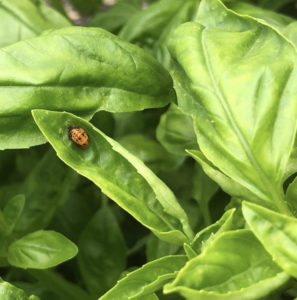 take shelter and lay their eggs even when one part of the garden is being turned under. If you don’t spray your garden with pesticides then some pests will be able to survive, which will give the hatching ladybug larvae something to eat. We aim to create a delicate balance wherein there are enough living pests to support a permanent predator population of Ladybugs, but not so many pests as to damage the crops. At our home ranch we’ve planted a drought tolerant hedgerow at the edge of our citrus orchard that is only a year old, but is already serving as habitat for aphids- and the Ladybugs that feed on them.
take shelter and lay their eggs even when one part of the garden is being turned under. If you don’t spray your garden with pesticides then some pests will be able to survive, which will give the hatching ladybug larvae something to eat. We aim to create a delicate balance wherein there are enough living pests to support a permanent predator population of Ladybugs, but not so many pests as to damage the crops. At our home ranch we’ve planted a drought tolerant hedgerow at the edge of our citrus orchard that is only a year old, but is already serving as habitat for aphids- and the Ladybugs that feed on them.
—© 2021 Essay by Andy Griffin and photos by Starling Linden and Andy Griffin
~Special Note~
As the weather is getting warmer, the sun is rising earlier and the harvesting begins with the sunrise, we will be closing our East Bay/Peninsula shop by 6 PM on the Wednesday evenings before the Friday delivery. We close our San Francisco & Mystery Thursday shops on Wednesday mornings by 8 AM and our Santa Cruz/Los Gatos shop by 8 AM, on Monday mornings. Please get your orders in early so you don’t miss out on the harvest! Thank you all again for being such a part of our bountiful farm!
If you haven’t ordered a Mystery Box recently, now is a great time to get in on spring deliciousness! LadybugBuyingClub
The Many Scents of Lavender
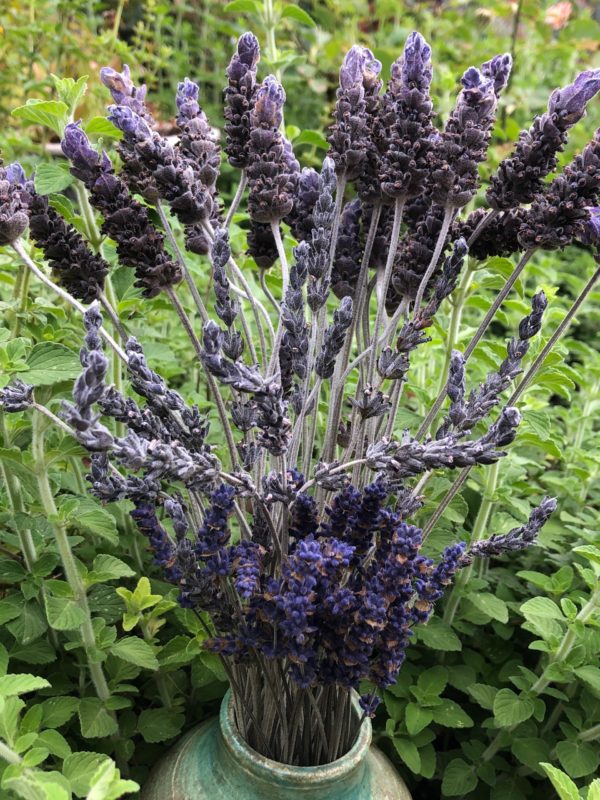
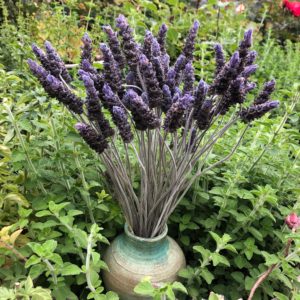 Spanish lavender, or Lavandula stoechas, is a Mediterranean lavender that is very robust and hardy and can grow from a tiny seedling into a waist high shrub in a year. This is the lavender species that was most likely grown or gathered from the wild during the ancient times. Lavandula stoechas has flower buds that are big, fat, and almost tarry with very aromatic essential oils. Most people believe that this highly scented herb got its name from the Latin verb, “lavare,” meaning “to wash,” because lavender plants were used to make soap or used in infusions to fumigate clothes. The word Latin “Lavare” is cognate with the modern English word “laundry” and the Middle English word “Lavendrye,” meaning “place of washing.” Of course the Etymologists are just as prone to controversy as the Botanists, so there are rogue wordsmiths who believe that Lavender takes its name from the Latin “livere,” meaning “blueish.” Whatever…..
Spanish lavender, or Lavandula stoechas, is a Mediterranean lavender that is very robust and hardy and can grow from a tiny seedling into a waist high shrub in a year. This is the lavender species that was most likely grown or gathered from the wild during the ancient times. Lavandula stoechas has flower buds that are big, fat, and almost tarry with very aromatic essential oils. Most people believe that this highly scented herb got its name from the Latin verb, “lavare,” meaning “to wash,” because lavender plants were used to make soap or used in infusions to fumigate clothes. The word Latin “Lavare” is cognate with the modern English word “laundry” and the Middle English word “Lavendrye,” meaning “place of washing.” Of course the Etymologists are just as prone to controversy as the Botanists, so there are rogue wordsmiths who believe that Lavender takes its name from the Latin “livere,” meaning “blueish.” Whatever…..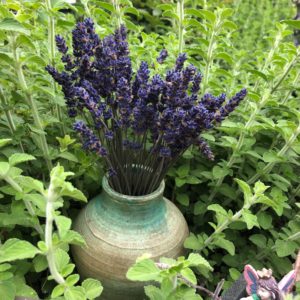 Lavandula dentata. I’m using it to refer to a Lavandula dentata variety that has a thinner flower bud than the “Spanish” lavender as well as a somewhat different scent. The French worked with Lavender species to create varieties that were especially useful in the perfume trade. Lavandula dentata has a more refined look to the stem and a somewhat less aggressive habit of growth than the “Spanish lavender.” It’s worth noting that the French refer to Lavandula dentata as “English lavender.” We’re not ICE agents here, so we’re not checking passports. We value the Lavandula dentata varieties for their scent and for the nice, long, spicy wands we can make from their dried stems.
Lavandula dentata. I’m using it to refer to a Lavandula dentata variety that has a thinner flower bud than the “Spanish” lavender as well as a somewhat different scent. The French worked with Lavender species to create varieties that were especially useful in the perfume trade. Lavandula dentata has a more refined look to the stem and a somewhat less aggressive habit of growth than the “Spanish lavender.” It’s worth noting that the French refer to Lavandula dentata as “English lavender.” We’re not ICE agents here, so we’re not checking passports. We value the Lavandula dentata varieties for their scent and for the nice, long, spicy wands we can make from their dried stems.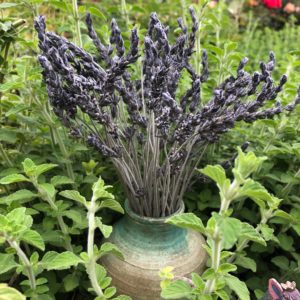 “English lavender,” or Lavandula angustifolia, is yet another complex tribe of lavenders. Like it’s Spanish and French cousins, English lavender is a highly scented member of the Lamiaceae, or mint family, and compared to them it has flowers that are on the purple end of the spectrum. The English lavenders we’re growing are typically shorter in stature with a brighter blue to the flower petals than the French types. Our English lavenders are the most disciplined and compact in their growth habit, making them the most desirable plant to use as a low hedge in a labyrinth, and they make nice, smaller bouquets. Over the last 100 years there’s been more culinary interest in lavender than in the past. Yes, long ago Lavandula stoechas was used to make spiced wine, but in these days the English types have been more frequently used to flavor pastas, desserts, or teas. Please note that drying increases the “potency” of lavender, so if you choose to cook with lavender you can use rather less dried lavender than fresh flowers to achieve the same effect.
“English lavender,” or Lavandula angustifolia, is yet another complex tribe of lavenders. Like it’s Spanish and French cousins, English lavender is a highly scented member of the Lamiaceae, or mint family, and compared to them it has flowers that are on the purple end of the spectrum. The English lavenders we’re growing are typically shorter in stature with a brighter blue to the flower petals than the French types. Our English lavenders are the most disciplined and compact in their growth habit, making them the most desirable plant to use as a low hedge in a labyrinth, and they make nice, smaller bouquets. Over the last 100 years there’s been more culinary interest in lavender than in the past. Yes, long ago Lavandula stoechas was used to make spiced wine, but in these days the English types have been more frequently used to flavor pastas, desserts, or teas. Please note that drying increases the “potency” of lavender, so if you choose to cook with lavender you can use rather less dried lavender than fresh flowers to achieve the same effect.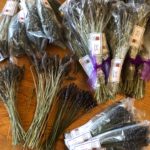 So far, so good. Hopefully the Covid crisis will end soon. By the end of the year I’m hoping to have the labyrinth finished. In the future we’ll be able to invite people to walk the lavender scented paths with us. And right now we’re enjoying a nice harvest on all the lavenders we planted before Covid when we were testing out our location and our soil to see if the plants would do well here. They do! And this week we’ve got a “Lavender Flight” special to offer, with a bunch each of Spanish, French, and English lavender so that you can enjoy their different their scents.
So far, so good. Hopefully the Covid crisis will end soon. By the end of the year I’m hoping to have the labyrinth finished. In the future we’ll be able to invite people to walk the lavender scented paths with us. And right now we’re enjoying a nice harvest on all the lavenders we planted before Covid when we were testing out our location and our soil to see if the plants would do well here. They do! And this week we’ve got a “Lavender Flight” special to offer, with a bunch each of Spanish, French, and English lavender so that you can enjoy their different their scents.—© 2021 Essay by Andy Griffin and photos by Starling Linden
~Special Note~
As the weather is getting warmer, the sun is rising earlier and the harvesting begins with the sunrise, we will be closing our East Bay/Peninsula shop by 6 PM on the Wednesday evenings before the Friday delivery. We close our San Francisco & Mystery Thursday shops on Wednesday mornings by 8 AM and our Santa Cruz/Los Gatos shop by 8 AM, on Monday mornings. Please get your orders in early so you don’t miss out on the harvest! Thank you all again for being such a part of our bountiful farm!
If you haven’t ordered a Mystery Box recently, now is a great time to get in on spring deliciousness! LadybugBuyingClub
The Milpa and the Holy Trinity
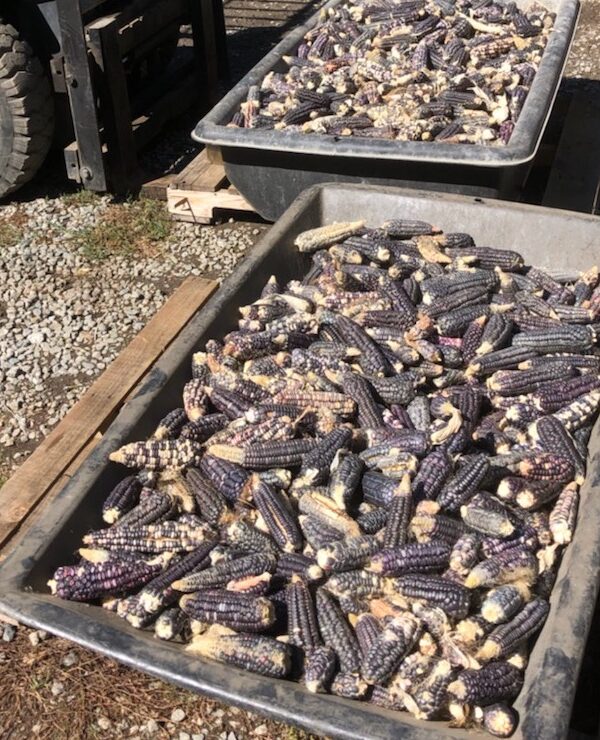
We planted the first stage of our little “milpa” this weekend. A milpa is a “corn patch.” The City of Milpitas is named after the little corn patches that characterised the area during California’s Spanish colonial period. But a classic traditional milpa is always more than corn. The Mesoamerican farmers who created the milpa typically grew a diversity of crops in their corn fields. The corn stalks grew high and vining beans snaked up the stalks, using them for support. Broad leaved squash plants would grow between the scattered hummocks of corn, and the dense canopy they formed would choke out the weeds. Crops that we moderns might think of as noxious weeds to be exterminated, like pigweed or lambsquarters, were “quelites” to the farmers of the milpas and they’d gather them to add leafy greens to their diet. A fully realized milpa consisted of Corn, squash, and beans -the Holy Trinity- surrounded by a cohort of useful and nutritious herbs.
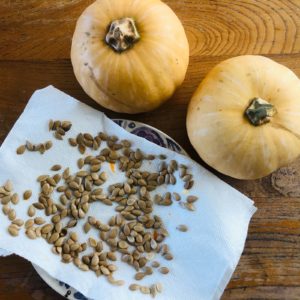 I’m playing around with the milpa idea for fun, and to see how well it works out in practice. I see my milpa as a typical type garden which might be found anywhere along the French-Mexican border. For my hard squash I’ve chosen to plant “Doran,” an heirloom French squash for the Cucurbita moschata- like a butternut, but round, like a pumpkin. I think the Doran hard squash will be an excellent size for our farm’s supporters, since they’re small enough for us to fit in the box and for our supporters to consume in one meal. We received seed for this crop from our friend and neighbor, Zea, at Fruitilicious Farm, who has been saving this old fashion variety. Any purslane weeds that come up in our milpa we’ll let go to seed so that we can have “verdolaga.” Purslane, AKA Verdolaga, which is esteemed as a cooking green in both the French and Mexican traditions.
I’m playing around with the milpa idea for fun, and to see how well it works out in practice. I see my milpa as a typical type garden which might be found anywhere along the French-Mexican border. For my hard squash I’ve chosen to plant “Doran,” an heirloom French squash for the Cucurbita moschata- like a butternut, but round, like a pumpkin. I think the Doran hard squash will be an excellent size for our farm’s supporters, since they’re small enough for us to fit in the box and for our supporters to consume in one meal. We received seed for this crop from our friend and neighbor, Zea, at Fruitilicious Farm, who has been saving this old fashion variety. Any purslane weeds that come up in our milpa we’ll let go to seed so that we can have “verdolaga.” Purslane, AKA Verdolaga, which is esteemed as a cooking green in both the French and Mexican traditions. the trade as Scarlet Runner beans or “Akahana Mame.” I’ll wait until the corn is up before I plant the beans so that they won’t choke the poor corn plants out. And to help the beans find direction up I’m also putting some sunflowers in my milpa. Sunflowers are another gift of the Americas to the rest of the world, and the ancient farmers who developed them treated them as a grain crop for their rich seed. I don’t think I can beat our local birds to a crop of sunflower seeds, so I’m growing some ornamental varieties for late summer bouquets.
the trade as Scarlet Runner beans or “Akahana Mame.” I’ll wait until the corn is up before I plant the beans so that they won’t choke the poor corn plants out. And to help the beans find direction up I’m also putting some sunflowers in my milpa. Sunflowers are another gift of the Americas to the rest of the world, and the ancient farmers who developed them treated them as a grain crop for their rich seed. I don’t think I can beat our local birds to a crop of sunflower seeds, so I’m growing some ornamental varieties for late summer bouquets.We have a lot to look forward to this fall and I can’t wait to see what comes out of the milpa.
—© 2021 Essay and Photos by Andy Griffin.
~Special Note~
As the weather is getting warmer, the sun is rising earlier and the harvesting begins with the sunrise, we will be closing our East Bay/Peninsula shop by 6 PM on the Wednesday evenings before the Friday delivery. We close our San Francisco & Mystery Thursday shops on Wednesday mornings by 8 AM and our Santa Cruz/Los Gatos shop by 8 AM, on Monday mornings. Please get your orders in early so you don’t miss out on the harvest! Thank you all again for being such a part of our bountiful farm!
If you haven’t ordered a Mystery Box recently, now is a great time to get in on spring deliciousness! LadybugBuyingClub
Brand New Potatoes!
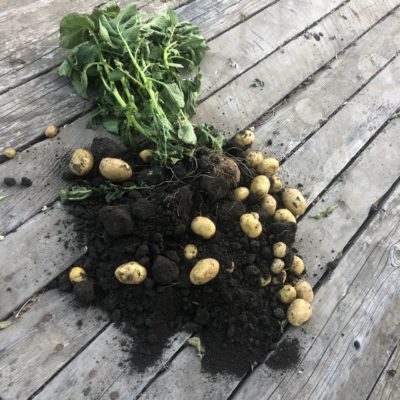
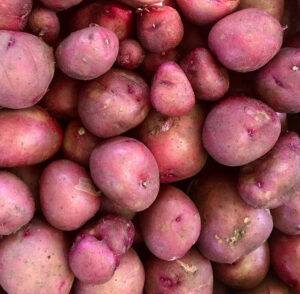 high, and when they start to bloom we know that they are setting a new crop of potato tubers underground. Red skinned potatoes make rose colored flowers. Yellow and white potatoes have white blossoms, and purple potatoes have purple flowers. If these flowers get pollinated they will eventually form small, hard green fruits full of seed that resemble their tomato cousins, but we don’t worry about them. Instead, we wait for the potato plants to turn yellow, then wilt, and “die back.”
high, and when they start to bloom we know that they are setting a new crop of potato tubers underground. Red skinned potatoes make rose colored flowers. Yellow and white potatoes have white blossoms, and purple potatoes have purple flowers. If these flowers get pollinated they will eventually form small, hard green fruits full of seed that resemble their tomato cousins, but we don’t worry about them. Instead, we wait for the potato plants to turn yellow, then wilt, and “die back.”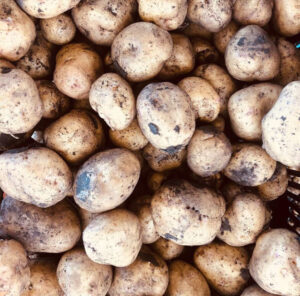 them to the pigs, but I save them. I like to make an early, thick planting of these cull potatoes that are too ugly to sell. When I see this crop flower I know there is a swarm of tiny potatoes growing underground. Once the young potatoes have swollen to about the size of golf balls we’ll dig them up as “new potatoes.” The gophers, beetles, and wild pigs that would gobble up our potato crop are not stupid; they know that there is almost nothing on earth as succulent and tasty as a fresh, young potato.
them to the pigs, but I save them. I like to make an early, thick planting of these cull potatoes that are too ugly to sell. When I see this crop flower I know there is a swarm of tiny potatoes growing underground. Once the young potatoes have swollen to about the size of golf balls we’ll dig them up as “new potatoes.” The gophers, beetles, and wild pigs that would gobble up our potato crop are not stupid; they know that there is almost nothing on earth as succulent and tasty as a fresh, young potato.—© 2021 Essay and Photos by Andy Griffin.
~Special Note~
As the weather is getting warmer, the sun is rising earlier and the harvesting begins with the sunrise, we will be closing our East Bay/Peninsula shop by 6 PM on the Wednesday evenings before the Friday delivery. We close our San Francisco & Mystery Thursday shops on Wednesday mornings by 8 AM and our Santa Cruz/Los Gatos shop by 8 AM, on Monday mornings. Please get your orders in early so you don’t miss out on the harvest! Thank you all again for being such a part of our bountiful farm!
If you haven’t ordered a Mystery Box recently, now is a great time to get in on spring deliciousness! LadybugBuyingClub
What Kind of Pea?
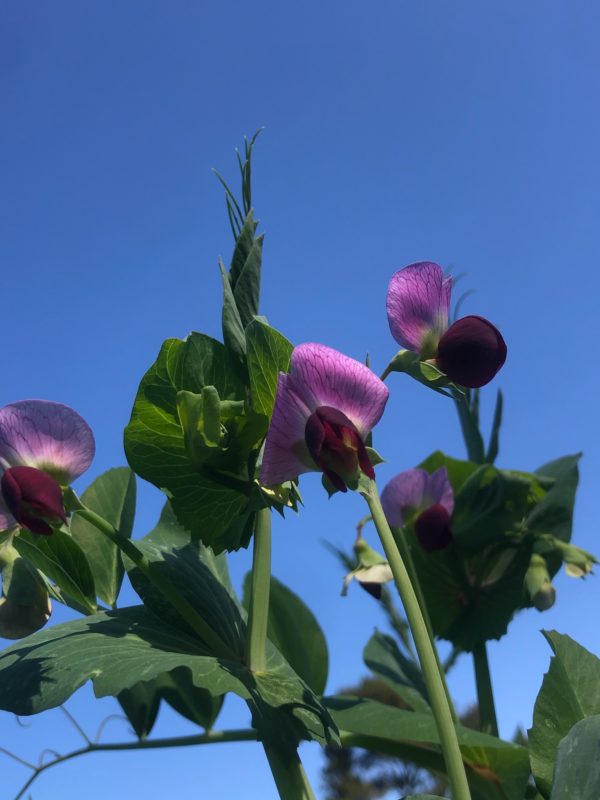
The girl was SO insanely sensitive, and yet her morbid fragility was somehow proof positive of her nobility? I was confused. Do you remember the Princess and the Pea? As a youth, I puzzled over her story. The poor thing couldn’t sleep. She complained that she’d tossed and turned all night because of a stone in her bed, and after the palace staff pulled the bedding from the frame, seven feather comforters in all, they found that it was a single, tiny dried pea seed at the bottom that had provoked all the distress. Why were we supposed to validate this girl’s hyper-sensitivity by crowning her? Compare the Princess of the pea to Tanya Tucker, the reigning “princess” of Country Music when I was a young. “Would you lay with me in a field of stone?” Tanya sang. She was 14 at the time, a year older than I was. Now that I’m an old fart with a snail mail box full of cremation insurance offers and AARP fliers I’m not so worried about figuring women out. I find myself wondering more about the pea that caused the Princess so much discomfort. “What kind of pea was it ?” I ask myself. The answer is not obvious.
Pea Soup Andersen’s, a popular restaurant chain for travelers with locations along California’s Highway 101 as well as on I-5, bases its menu around “split-pea” soup. The pea that Andersen’s uses would be a modern variety of Pisum sativum that has been selected by plant scientists for its utility in producing dried peas. A “Split pea” is not a
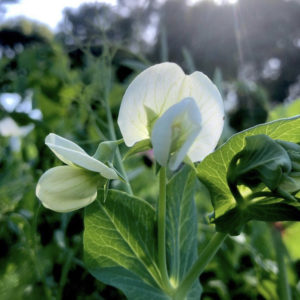
Snow pea flowers
specific variety of pea.The pea plant is a “dicotyledon,” meaning that the seed is an embryonic plant that will germinate to present a pair (“di”) of infant leaves (cotyledons). A dried pea seed can be “split” into two halves, each part being a half of the starchy dicot pair that is enveloped by the hull of the seed. The Snow pea, the Sugar Snap pea, and the English pea are also varieties of Pisum sativum developed for use as fresh vegetables, but you could let their seeds mature on the vine until dry, then “split” them and make them into soup too, if you wanted or needed to.
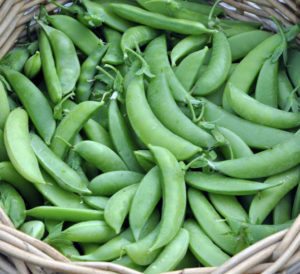 So the controversy can’t be resolved at the moment. For the last couple of weeks we’ve been enjoying snap peas. This week we begin the English Pea harvest. We even have planted a crop of Chickpeas, and we’ll see how they do. Peas of any kind are an important crop for the farm because they are legumes. Legume species have the important ability to capture unusable atmospheric nitrogen and convert it into a form that plants can use as fertilizer. Legumes have a symbiotic relationship with a bacteria that infect the roots of the host plants and pay for their stay taking in and digesting nitrogen gas, then excreting it in a form that is available to the plant. That’s pretty “magical,” if you ask me. We grow peas to feed you, but we also plant peas in our cover crops to feed the soil so that we can keep farming the land happily ever after.
So the controversy can’t be resolved at the moment. For the last couple of weeks we’ve been enjoying snap peas. This week we begin the English Pea harvest. We even have planted a crop of Chickpeas, and we’ll see how they do. Peas of any kind are an important crop for the farm because they are legumes. Legume species have the important ability to capture unusable atmospheric nitrogen and convert it into a form that plants can use as fertilizer. Legumes have a symbiotic relationship with a bacteria that infect the roots of the host plants and pay for their stay taking in and digesting nitrogen gas, then excreting it in a form that is available to the plant. That’s pretty “magical,” if you ask me. We grow peas to feed you, but we also plant peas in our cover crops to feed the soil so that we can keep farming the land happily ever after.—© 2021 Essay and Photos by Andy Griffin.
~Special Note~
As the weather is getting warmer, the sun is rising earlier and the harvesting begins with the sunrise, we will be closing our East Bay/Peninsula shop by 6 PM on the Wednesday evenings before the Friday delivery. We close our San Francisco & Mystery Thursday shops on Wednesday mornings by 8 AM and our Santa Cruz/Los Gatos shop by 8 AM, on Monday mornings. Please get your orders in early so you don’t miss out on the harvest! Thank you all again for being such a part of our bountiful farm!
If you haven’t ordered a Mystery Box recently, now is a great time to get in on spring deliciousness! LadybugBuyingClub
A Different Type of Sting!
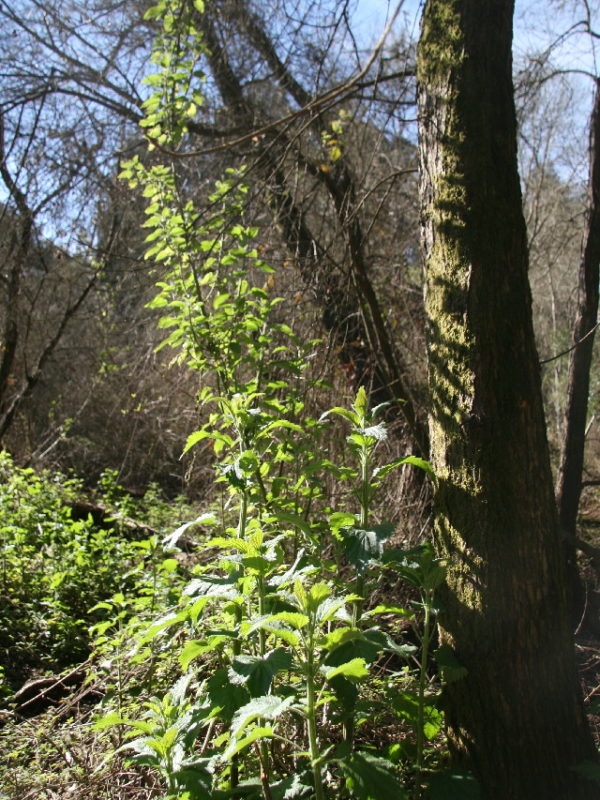
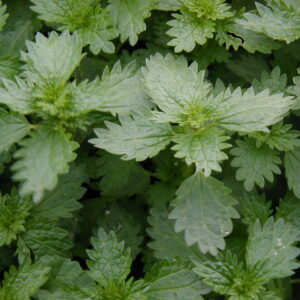 Garden nettles “belong” in the garden; they’re only weeds when or where I don’t want them growing. Sometimes when I have a nice patch of tender, garden nettles I’ll harvest and sell them to the folks that know these “weeds” were brought to California by Italian immigrants who grew them as cooking greens. Garden nettles are excellent used, like spinach, to make savory green sauces or winter-time ravioli fillings. Steep a pinch of garden nettles in hot water and you’ll have a soothing glass of herbal tea in minutes.
Garden nettles “belong” in the garden; they’re only weeds when or where I don’t want them growing. Sometimes when I have a nice patch of tender, garden nettles I’ll harvest and sell them to the folks that know these “weeds” were brought to California by Italian immigrants who grew them as cooking greens. Garden nettles are excellent used, like spinach, to make savory green sauces or winter-time ravioli fillings. Steep a pinch of garden nettles in hot water and you’ll have a soothing glass of herbal tea in minutes.One day at the Farmers Market a frequent market shopper breezed past the sign I’d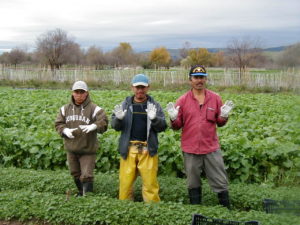 posted at the back of my stall that read “BEWARE- STINGING NETTLES. USE TONGS TO HANDLE!” She thrust her hands into the fresh nettles and then let out a little squeak of pain. I stepped over to point to the sign and hand her the tongs. “They’re not called ‘stinging nettles’ for nothing,” I said.
posted at the back of my stall that read “BEWARE- STINGING NETTLES. USE TONGS TO HANDLE!” She thrust her hands into the fresh nettles and then let out a little squeak of pain. I stepped over to point to the sign and hand her the tongs. “They’re not called ‘stinging nettles’ for nothing,” I said.
—© 2021 Essay by Andy Griffin.
~Special Note~
As the weather is getting warmer, the sun is rising earlier and the harvesting begins with the sunrise, we will be closing our East Bay/Peninsula shop by 6 PM on the Wednesday evenings before the Friday delivery. We close our San Francisco & Mystery Thursday shops on Wednesday mornings by 8 AM and our Santa Cruz/Los Gatos shop by 8 AM, on Monday mornings. Please get your orders in early so you don’t miss out on the harvest! Thank you all again for being such a part of our bountiful farm!
If you haven’t ordered a Mystery Box recently, now is a great time to get in on spring deliciousness! LadybugBuyingClub
From Oaxaca to Watsonville
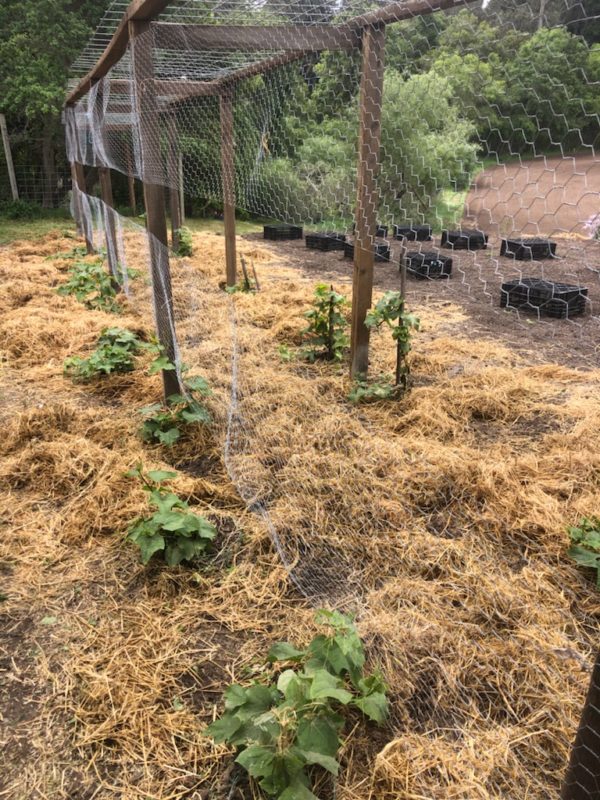
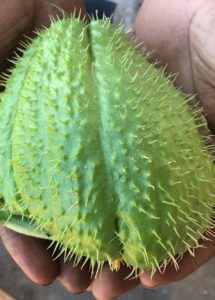
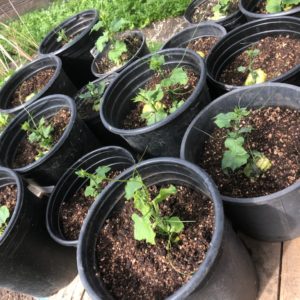 a number of different chayote plants of different varieties; smooth skinned, spiny, white-fruited, yellow fruited, green fruited. He told me how to protect the tubers from the gophers by putting them in wire baskets so that the plants could sprout back from underground every year as soon as the soil warmed up. And Fidel encouraged me to top off the frame with a rigid and strong mesh so that the squash can hang down to be picked easily by reaching up into the foliage with a pair of clippers. So far, so good. As the weather has warmed the young chayote plants are picking up speed, and this weekend, as cold as it was, the first vines still managed to grab onto the wire mesh and start their ascent. In the fields our summer squash are just flowering, but our chayotes won’t be ready until early fall. That should work out perfectly. I planted 20 plus chayote seedlings, and this planting will likely provide us with many, many pounds of harvest. At the very least we’ll be able to select out the varieties that perform the best here in Watsonville.
a number of different chayote plants of different varieties; smooth skinned, spiny, white-fruited, yellow fruited, green fruited. He told me how to protect the tubers from the gophers by putting them in wire baskets so that the plants could sprout back from underground every year as soon as the soil warmed up. And Fidel encouraged me to top off the frame with a rigid and strong mesh so that the squash can hang down to be picked easily by reaching up into the foliage with a pair of clippers. So far, so good. As the weather has warmed the young chayote plants are picking up speed, and this weekend, as cold as it was, the first vines still managed to grab onto the wire mesh and start their ascent. In the fields our summer squash are just flowering, but our chayotes won’t be ready until early fall. That should work out perfectly. I planted 20 plus chayote seedlings, and this planting will likely provide us with many, many pounds of harvest. At the very least we’ll be able to select out the varieties that perform the best here in Watsonville.—© 2021 Essay and Photos by Andy Griffin.
Top photo is the Growing Chayote Vines.
If you haven’t ordered a mystery box recently, now is a great time to get in on spring deliciousness! LadybugBuyingClub
